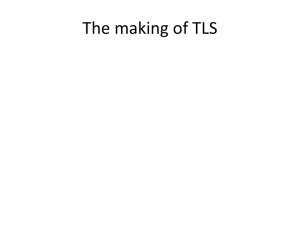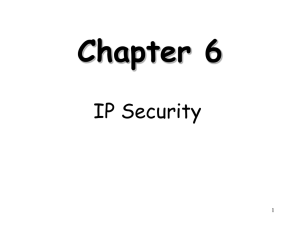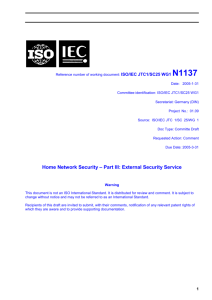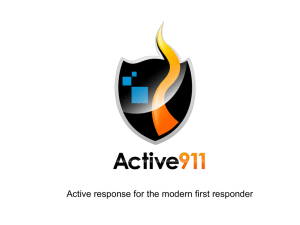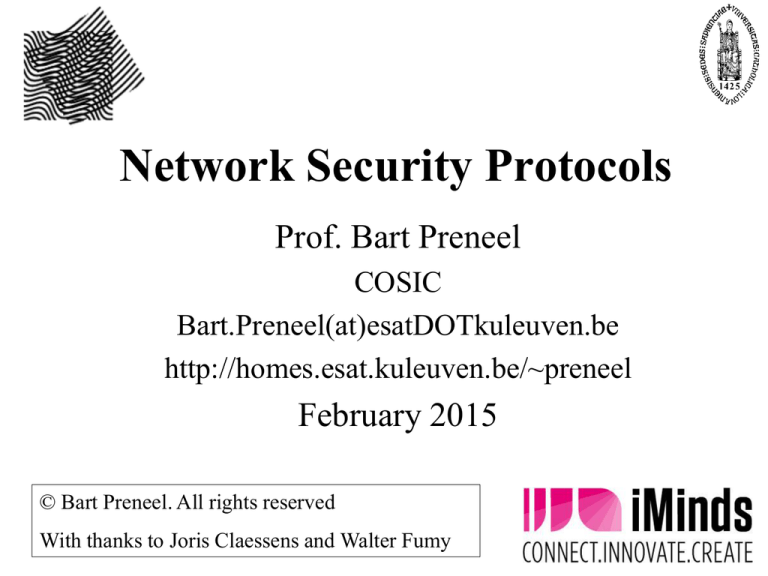
Network Security Protocols
Prof. Bart Preneel
COSIC
Bart.Preneel(at)esatDOTkuleuven.be
http://homes.esat.kuleuven.be/~preneel
February 2015
© Bart Preneel. All rights reserved
With thanks to Joris Claessens and Walter Fumy
Goals
• Understanding how security can be added to
the basic Internet protocols
• Understanding TLS and its limitations
• Understanding IPsec and its limitations
2
Outline
•
•
•
•
Internet summary
IETF process
Basic principles
Transport layer security
– SSL / TLS
• Network layer security
– IPSec, VPN, SSH
3
Internet Evolution
(prediction from 2000)
1800 Subscriptions worldwide (millions)
1600
mobile
subscribers
Mobile
Fixed
1400
Mobile Internet
1200
Fixed Internet
mobile
Internet
subscribers
1000
800
600
400
200
0
1995
2000
2005
2010
4
Internet Evolution
(prediction from April 2010)
2.1 billion internet users worldwide in March 2011 (30.2%)
Source: Internet World Stats
5
The Internet - A Network of Networks
• “IP is the protocol that integrates all infrastructures”
Internet
Workstation,
PC, Laptop,
PDA, ...
IP Router
Network A
various
transmission
technologies
Ethernet
Token Ring
WLAN
Powerline
Workstation,
PC, Laptop,
PDA, ...
IP Router
Network B
DECT
GSM
UMTS
Satellites
Network C
PSTN
ISDN
ATM
Frame Relay
6
Internet Protocols
SMTP
HTTP
TCP/UDP
IP
Link
...
Application
SMTP
HTTP
...
Transport
TCP/UDP
Network
IP
Link
• Network Layer
– Internet Protocol (IP)
• Transport Layer
– Transmission Control Protocol (TCP), User Datagram
Protocol (UDP)
7
Data Encapsulation
Application Layer
(Web, FTP, ... )
Data
Transport Layer
(TCP, UDP)
Data
Transport Layer
(TCP, UDP)
Transport
Transport
Header
Transport
Header
Data
Network Layer
(IP)
IP Header
Application Layer
(Web, FTP, ... )
Application
Data
Network Layer
(IP)
Network
Transport
Header
Data
IP Header
Network Access
Layer
Transport
Header
Data
Network Access
Layer
Internet
8
Internet Standardization
• ISOC/IAB/IESG/IETF
• Internet Engineering Task Force (IETF)
• IETF Working Groups
–
–
–
–
–
Mailing List Information
Scope of the Working Group
Goals and Milestones
Current Internet Drafts & RFCs
http://www.ietf.org/html.charters/wg-dir.html
• RFCs
– http://www.rfc-editor.org
– ftp://FTP.ISI.EDU/in-notes/
9
IETF Standards: RFC
– Proposed Standard (PS)
• stable spec
• lowest level of standards track
– Draft Standard (DS)
• at least two independent and
interoperable implementations
Experimental
Proposed
Draft std
– Standard (STD)
• widely, successfully used
Standard
Historic
10
IETF Intermediate documents
• Request for Comments (RFCs) with different
maturity levels
–
–
–
–
Experimental (E)
Informational (I)
Historic (H)
Best Current Practice (BCP) – does not influence bits on the wire
• Internet-Drafts (I-D) are working documents of the
working groups and have no formal status
• Protocol Status (requirement level)
– "required", "recommended", "elective",
"limited use", or "not recommended”
– “must” and “should”
11
IETF Security Area
Area Directors: Stephen Farrell and Kathleen Moriarty
abfab
dane
dkim
emu
ipsecme
jose
kitten
krb-wg
mile
nea
oauth
pkix
tls
Application Bridging for Federated Access Beyond web
DNS-based Authentication of Named Entities
Domain Keys Identified Mail
EAP Method Update
IP Security Maintenance and Extensions
Javascript Object Signing and Encryption
Common Authentication Technology Next Generation
Kerberos
Managed Incident Lightweight Exchange
Network Endpoint Assessment
Open authentication
Public-Key Infrastructure (X.509)
Transport Layer Security
security work in other areas:
Keying and Authentication for Routing Protocols
Secure Inter-Domain Routing
DNS Extensions
Web Security
12
Communications insecurity
• architectural errors
– wrong trust assumptions
– default = no security
• protocol errors
– unilateral entity authentication
– weak entity authentication mechanism
– downgrade attack
• modes of operation errors
– no authenticated encryption
– wrong use of crypto
• cryptographic errors
range of wireless
communication
is often
underestimated!
– weak crypto
• implementation errors
13
A historical perspective (1)
1900
wireless
data
Vernam:
OTP
1900
1980
1960
rotor
machines
wired
data
LFSR
1960
1900
2000
WLAN
PAN
3GSM
1980
1990
2000
block
X25 TLS SSH
ciphers
IPsec
digital
encryption
wired
voice
1990
1960
analog scramblers
1980
STU
1990
2000
VoIP
14
A historical perspective (2)
mobile
phones
1980
1990
3G
GSM/TDMA
AMPS
analog cloning,
scanners
TDMA
cloning
WLAN
LTE
attacks on A5,
COMP128
1997
2002
WEP
WPA
WEP
broken
PAN
2010
2000
1999
2004
WPA2/802.11i
WPA
weak
2007
Bluetooth
Bluetooth
2.1
15
Bluetooth problems
Security Goals (started in ISO 7498-2)
• confidentiality:
– entities (anonimity)
– data
– traffic flow
• (unilateral or mutual) entity authentication
• data authentication (connection-less or
connection-oriented): data origin authentication
+ data integrity
• access control
• non-repudiation of origin versus deniability
16
Security Protocols & Services
• Cryptographic techniques:
–
–
–
–
symmetric encipherment
message authentication mechanisms
entity authentication mechanisms
key establishment mechanisms (e.g., combined
with entity authentication)
SP hdr
data
SP tlr
MAC
confidentiality
integrity
17
Internet Security Protocols
Electronic Commerce Layer
PayPal, Ecash, 3D Secure ...
S-HTTP
PGP
PEM
S/MIME
Transport Layer Security (SSH,
SSL, TLS)
Transmission Control Protocol
(TCP)
PKIX
SPKI
User Datagram Protocol (UDP)
IP/ IPSec (Internet Protocol Security)
Public-Key
Infrastructure
• security services depend on the layer of integration:
– the mechanisms can only protect the payload and/or header
information available at this layer
– header information of lower layers is not protected!!
18
Security: at which layer?
• Application layer:
–
–
–
–
closer to user
more sophisticated/granular controls
end-to-end
but what about firewalls?
• Lower layer:
– application independent
– hide traffic data
– but vulnerable in middle points
• Combine?
19
SP Architecture I: Encapsulation
unprotected data
SP hdr
encrypted data
MAC
confidentiality
integrity
• Bulk data: symmetric cryptography
• Authenticated encryption: best choice is to
authenticate the ciphertext
20
SP Architecture II:
Session (Association) Establishment
Host A
Host B
SP hdr
encrypted data
MAC
Security Associations
(Security Parameters
incl. Shared Keys)
Key Management and
Security Association Establishment
Protocols
21
Algorithm Selection
"a la carte“
• each algorithm (encryption,
integrity protection, pseudorandom function, DiffieHellman group, etc.) is
negotiated independently
• less compact to encode
• more flexible
“suite”
• all parameters are encoded
into a single suite number;
negotiation consists of offering
one or more suites and having
the other side choose
• simpler and more compact to
encode
• potentially exponential
number of suites
• less flexible
• e.g., IKEv1
• e.g., TLS and IKEv2
22
Transport layer security
SSL / TLS
SSL/TLS Protocols
Secure
WWW Server
Browser
http://
https://
SSL
SSL
Transport System
Transport System
HTTP over SSL
HTTP
– connection-oriented data confidentiality and
integrity, and optional client and server
authentication.
24
Transport Layer Security Protocols
• IETF Working Group:
Transport Layer Security (tls)
Application
Data
Application
– RFC 2246 (PS), 01/99
• transparent secure channels
independent of the respective
application.
• available protocols:
– Secure Shell (SSH),
SSH Ltd.
– Secure Sockets Layer (SSL),
Netscape
– Transport Layer Security
(TLS), IETF
TLS
Encapsulation
Decapsulation
Negotiation
Authentication
Key Establishment
TCP
Protected
Data
Handshake
IP
25
SSL / TLS
• Mainly in context of WWW security, i.e., to
secure the HyperText Transfer Protocol
(HTTP)
• TLS: security at the transport layer
– can be used (and is intended) for other applications too
(IMAP, telnet, ftp, …)
– end-to-end secure channel, but nothing more...
– data is only protected during communication
– no non-repudiation!
26
Other WWW security protocols
• PCT: Microsoft’s alternative to SSL
• S-HTTP: S/MIME-like protocol
• SET: e-payment protocol for credit card
transactions
• XML-Signature: PKCS#7-based signature
on XML documents
• ...
27
SSL/TLS
• “Secure Sockets Layer” (Netscape)
– SSL 2.0 (1995): security flaws!
– SSL 3.0 (1006): still widely used - not interoperable with TLS 1.0
• “Transport Layer Security” (IETF)
– TLS 1.0 (01/99) adopted SSL 3.0 with minor changes - RFC 2246 default DSA/3DES
– TLS 1.1 (4/2006) - RFC 4346 – default: RSA/3DES; several fixes
for padding oracle and timing attacks (explicit IV for CBC)
– TLS 1.2 (8/2008) - RFC 5246
• replaces MD5 and SHA-1 by SHA-256 (SHA-1 still in a few places)
• add AES ciphersuites (but still supports RC4!)
• add support for authenticated encryption: GCM and CCM
– RFC 5176 (2/2011) removes backward compatibility with SSL 2.0
– Currently 314 ciphersuites!
TLS 1.1 and 1.2 deployment very slow (about 25% of servers in Feb. 14);
boost in Nov. 2013 (new attacks + Snowden revelations).
28
A p p lic a tio n
e .g ., h ttp , te ln e t, ...
A p p lic a tio n
D a ta
H a n d sh a k e P ro to c o l
C lie n t H e llo
S e rv e r H e llo
...
C h a n g e C ip h e r S p e c
P ro to c o l
A le rt
P ro to c o l
A p p lic a tio n
P ro to c o l
C hange
C ip h e r S p e c
A le rt
A p p lic a tio n
D a ta
...
R e c o rd L a ye r P ro to c o l
S S L re c o rd
T ra n sp o rt la ye r
T C P /IP
29
SSL/TLS in more detail
• “Record layer” protocol
– fragmentation
– compression (not in practice)
– cryptographic security:
• encryption data confidentiality
• MAC data authentication [no digital signatures!]
• “Handshake” protocol
– negotiation of cryptographic algorithms
– client and server authentication
– establish cryptographic keys (master key and derived
key for encryption and MAC algorithm)
– key confirmation
30
Handshake: overview
CLIENT
SERVER
Hello Request
Client Hello
Server Hello
Certificate
Certificate
Client Key Exchange
Server Key Exchange
Certificate Verify
Certificate Request
[changecipherspec]
Server Hello Done
Finished
[changecipherspec]
start handshake, protocol version, algorithms
authentication server + exchange (pre)master secret
client authentication
end handshake, integrity verification
Finished
31
TLS 1.2 Data Encapsulation Options
Integrity
key size
algorithm
options
144
160
256
HMACMD5
HMACSHA
HMACSHA256
mandatory
Confidentiality
key size
algorithm
options
40
RC4_40
RC2_CBC_40
DES_CBC_40
56
128
168
256
DES_CBC
RC4
IDEA_CBC
AES_CBC
3DES_
EDE_CBC
AES_CBC
mandatory
32
TLS 1.2 Key Management Options
Anonymous
DH_anon
vulnerable to a
meet-in-themiddle attack
mandatory
Non anonymous
Server authentication,
no client authentication
RSA
DH_DSS
DH_RSA
DHE_DSS
DHE_RSA
Server and client
authentication
RSA
DH_DSS
DH_RSA
DHE_DSS
DHE_RSA
33
Forward secrecy
• Default algorithm is RSA (better performance, at
least for RSA-1024)
• no forward secrecy: compromise of private server
key results in compromise of all past sessions
• DH-DSS and DH-DSA: same problem
• DHE-DSS and DHE-DSA: Ephemeral DiffieHellman keys leads to forward secrecy
• For performance reasons: switch to a 256-bit
Elliptic Curve (e.g. Google in November 2013)
DHE_DSS (notation from IKE)
proposed attributes
selected attributes
Initiator
Responder
gx, Ni
gy, Nr
K derived from
master = prf( Ni || Nr, gxy )
SIGi = Signature on
H( master, gx || gy || ... || IDi )
E(K, IDi, [Cert(i)], SIGi )
SIGr = Signature on
H( master, gy || gx || ... || IDr )
E(K, IDr, [Cert(r)], SIGr )
H is equal to prf or the hash function tied to the signature algorithm
(all inputs are concatenated)
SSL/TLS: security services
SSL/TLS only provides:
• entity authentication
• data confidentiality
• data authentication
SSL/TLS does not provide:
•
•
•
•
•
non-repudiation
unobservability (identity privacy)
protection against traffic analysis
secure many-to-many communications (multicast)
security of the end-points (but relies on it!)
36
36
SSL/TLS: security analysis
Detailed analysis and security reductions (“proofs”):
– Handshake protocol: most unaltered TLS ciphersuites form a secure
channel (authenticated and confidential channel establishment)
– Record layer protocol: Authenticated Encryption well understood (but
badly implemented)
Current analysis does not take into account the full complexity
– Cipher suites: negotiation, renegotiation, reuse of master key over
multiple suites
– Cross protocol attacks
– Fragmentation
– Compression
– Timing attacks
37
37
TLS overview [Stebila’14]
Crypto
primitives
RSA, DSA,
ECDSA
DH, EC-DH
HMAC
MD5, SHA-1,
SHA-2
Ciphersuite
details
Protocol
“Framework”
Libraries
Data structures
Alerts and errors
OpenSSL
Web browsers
Key derivation
Certification/revocation
GnuTLS
Web servers
SChannel
Application
SDKs
Encryption
modes and IVs
Padding
Compression
DES, 3DES,
RC4, AES
(Re-)Negotiation
Session
Resumption
Java JSSE0
Applications
Certificates
Key reuse
Theoretical
analysis
38
TLS attack overview [Stebila’14]
TLS attacks (1)
• Renegotiation attack (2009)
– allows injection of data; patched by RFC 5746
• Version rollback attacks (2011)
– exploits false start feature (introduced to improve performance)
• CRIME and BREACH attacks (2013)
– recovery of cookies when data compression is used
– all TLS versions are vulnerable
• Truncation attack (2013)
– suppress logout by injecting an unencrypted TCP FIN message
• Heartbleed (2014)
– Buffer over-read in OpenSSL implemenation
• Poodle (2014) Padding Oracle On Downgraded Legacy Encryption
– Man-in-the middle that exploits downgrade to SSL 3.0
40
TLS attacks (2)
• Padding oracle and timing attacks
– RSA
•
•
•
•
[Bleichenbacher 98] PKCS #1v1.5 – 1 million chosen ciphertexts (in practice 200,000);
[Klima+ 03] 40% improvement
[Bardou+ 12]: reduced to about 10,000 chosen ciphertexts
timing attack [Kocher’95], [Boneh-Brumley’03]
– CBC (IV and padding)
• padding [Rogaway], [Vaudenay 02] , [Canvel+ 03]: password recovery
• BEAST attack [Rizzo-Duon 11]: exploits IV issues - patched from TLS 1.1 onwards
• Lucky 13 [AlFardan-Paterson’13]: timing attack on CBC padding – no patch known
• Cryptographic attacks
–
–
–
–
Weak random number generators: Netscape, Debian, embedded devices…
Exhaustive key search: 40-bit and 56-bit keys
Cross-protocol attack: elliptic curve parameters can be read as DH-prime
Biases in RC4 (re-introduced to 50% of web in Feb. 2013 to stop BEAST attack)
[AlFardan+ 13] [Isobe+ 13]
41
TLS problems
• many PKI issues: revocation, root keys, fake certificates,
certificate parsing,…
• web spoofing and phishing
• what if the user does not know that a particular website has to use
SSL/TLS (solution HSTS – HTTP Strict Transport Security
(HSTS): mandate that you interact with particular servers using
https/TLS only)
• traffic analysis:
– length of ciphertext might reveal useful info
– time to retrieve a page indicates whether it has been retrieved before
42
TLS Renegotiation attack [Marsh Ray Nov.09]
• Cipher suite can be
renegotiated dynamically
throughout the session
– negotiation and renegotiation look
the same
• Person-In-The-Middle can
inject (plaintext) traffic in a
protected session as if it came
from a client
• Fix: TLS renegotiation
indication extension
RFC 5746 – Feb.’10
(84% deployment in Jan.’14)
Figure: L. O’Connor
43
Implementation attacks
Debian-OpenSSL incident [13 May 2008]
https://cseweb.ucsd.edu/~hovav/dist/debiankey.pdf
• Weak key generation:
only 32K keys
– easy to generate all private keys
– collisions
• Between 13-17 May 2008
280 bad keys out of 40K
(0.6%)
• Revocation problematic
44
44
TLS certificate "NULL" issue
• [Moxie Marlinspike 09] Black Hat
– browsers may accept bogus SSL certs
– CAs may sign malicious certs
• certificate for www.paypal.com\0.kuleuven.be will be
issued if the request comes from a kuleuven.be admin
• response by PayPal: suspend Moxie’s account
– http://www.theregister.co.uk/2009/10/06/paypal_banishes_ssl_hacker/
45
User authentication
First authentication, then authorization !
SSL/TLS client authentication:
– During handshake, client can digitally sign a specific
message that depends on all relevant parameters of secure
session with server
– Support by software devices, smart cards or USB tokens
– PKCS#12 key container provides software mobility
– rarely implemented
Usually another mechanism on top of SSL/TLS
46
TLS 1.3
• Reduce the number of cipher suites:
– only authenticated encryption with associated data (AEAD): AESGCM, AES-CCM,ARIA-GCM, Camellia-GCM, ChaCha/Poly1305
– only perfect forward secrecy (still RSA for signatures)
– no custom DH groups
• Forbid renegotiation but keep resumption with tickets
• Improve privacy: encrypt more of the handshake
• Improve latency: target: 1-RTT handshake for naive
clients but 0-RTT handshake for repeat connections
Backward compatibility remains very important because
of huge installed base
47
Network layer security
IPsec, VPN, SSH
IP Security Protocols
• IETF Working Group:
SA Establishment
Application /
Authentication
IP Security Protocol (ipsec)
IKE
Key
Establishment
Application
Security Architecture for the
Data
Internet Protocol
TCP/UDP
Handshake
– RFC 2401 (PS), 11/98
Encapsulation
• IP Authentication Header (AH)
IP/IPSec
Decapsulation
– RFC 2402 (PS), 11/98
• IP Encapsulating Security
Protected
Payload (ESP)
Data
– RFC 2406 (PS), 11/98
• Internet Key Exchange (IKE)
– RFC 2409 (PS), 11/98
• Large and complex………….
(48 documents)
– Application layer protocol for
negotiation of Security Associations • Mandatory for IPv6, optional
for IPv4
(SA) and Key Establishment
49
IPSec VPN models:
Hosts and Security Gateways
Internet
Untrusted Network
Host-tohost (not
VPN)
IPSec Gateway
IPSec Gateway
Internet
Untrusted Network
Branchto-branch
Trusted
Network
Trusted
Network
IPSec Gateway
Host-togateway
Internet
Untrusted Network
Trusted
Network
50
IPsec - Security services
•
•
•
•
Access control
Connectionless integrity
Data origin authentication
Rejection of replayed packets (a form of
partial sequence integrity)
• Confidentiality
• Limited traffic flow confidentiality
51
IPsec - Concepts
• Security features are added as extension
headers that follow the main IP header
– Authentication header (AH)
– Encapsulating Security Payload (ESP) header
• Security Association (SA)
– Security Parameter Index (SPI)
– IP destination address
– Security Protocol Identifier (AH or ESP)
52
IPsec - Parameters
•
•
•
•
•
•
•
•
sequence number counter
sequence counter overflow
anti-replay window
AH info (algorithm, keys, lifetimes, ...)
ESP info (algorithms, keys, IVs, lifetimes, ...)
lifetime
IPSec protocol mode (tunnel or transport)
path MTU (maximum transmission unit)
53
IKE Algorithm Selection
Mandatory Algorithms
Algorithm Type
IKE v1
IKE v2
DES-CBC
AES-128-CBC
HMAC-MD5
HMAC-SHA1
HMAC-SHA1
768 Bit
1536 Bit
Transfer Type 1
(Encryption)
ENCR_DES_CBC
ENCR_AES_128_CBC
Transfer Type 2
(PRF)
PRF_HMAC_SHA1
[RFC2104]
PRF_HMAC_SHA1
[RFC2104]
Transfer Type 3
(Integrity)
AUTH_HMAC_SHA1_96
[RFC2404]
AUTH_HMAC_SHA1_96
[RFC2404]
Payload Encryption
Payload Integrity
DH Group
Source: draft-ietf-ipsec-ikev2-algorithms-00.txt, May 2003
54
IPsec - Modes
• Transport (host-to-host)
– ESP: encrypts and optionally authenticates IP
payload, but not IP header
– AH: authenticates IP payload and selected
portions of IP header
• Tunnel (between security gateways)
– after AH or ESP fields are added, the entire
packet is treated as payload of new outer IP
packet with new outer header
– used for VPN
55
IPsec - AH Transport mode
• Security Parameters Index: identifies SA
• Sequence number: anti-replay
• Integrity Check Value: data authentication using
HMAC-SHA-1-96 or HMAC-MD5-96
IP hdr
upper layer data
IP hdr
AH (..., Seq. Num., ICV)
upper layer data
Integrity
(only header fields that are not changed or are changed in a predictable manner)
56
IPsec - AH Tunnel mode
IP hdr
upper layer data
New IP hdr AH (..., Seq. Num., ICV)
IP hdr
upper layer data
Integrity
(only header fields that are not changed or are changed in a predictable manner))
57
IPsec - ESP header
• Security Parameters Index: identifies SA
• Sequence number: anti-replay
• Encrypted payload data: data confidentiality using
DES, 3DES, RC5, IDEA, CAST, Blowfish
• Padding: required by encryption algorithm
(additional padding to provide traffic flow
confidentiality)
• Integrity Check Value : data authentication using
HMAC-SHA-1-96 or HMAC-MD5-96
58
IPsec - ESP Transport mode
IP hdr
IP hdr
upper layer data
ESP hdr
upper layer data
ESP tlr
ICV
Confidentiality
Integrity
59
IPsec - ESP Tunnel mode
IP hdr
new IP hdr
upper layer data
ESP hdr
IP hdr
upper layer data
ESP tlr
ICV
Confidentiality
Integrity
60
IPsec: Key management
• RFCs 2407, 2408, and 2409
• Manual
• Automated
– procedure / framework
• Internet Security Association and Key Management Protocol
(ISAKMP), RFC 2408 (PS)
– key exchange mechanism: Internet Key Exchange (IKE)
• Oakley: DH + cookie mechanism to thwart clogging attacks
• SKEME
61
IPsec: Key management
• IKE defines 5 exchanges
– Phase 1: establish a secure channel
• Main mode
• Aggressive mode
– Phase 2: negotiate IPSEC security association
• Quick mode (only hashes, PRFs)
– Informational exchanges: status, new DH group
• based on 5 generic exchanges defined in
ISAKMP
• cookies for anti-clogging
62
IPsec: Key management
• protection suite (negotiated)
– encryption algorithm
– hash algorithm
– authentication method:
• preshared keys, DSA, RSA, encrypted nonces
– Diffie Hellman group: 5 possibilities
63
IKE - Main Mode with Digital Signatures
proposed attributes
selected attributes
Initiator
Responder
gx, Ni
gy, Nr
K derived from
master = prf( Ni || Nr, gxy )
SIGi = Signature on
H( master, gx || gy || ... || IDi )
E(K, IDi, [Cert(i)], SIGi )
SIGr = Signature on
H( master, gy || gx || ... || IDr )
E(K, IDr, [Cert(r)], SIGr )
H is equal to prf or the hash function tied to the signature algorithm
(all inputs are concatenated)
64
IKE - Main Mode with Digital Signatures
• mutual entity authentication
• mutual implicit and explicit key
authentication
• mutual key confirmation
• joint key control
• identity protection
• freshness of keying material
• perfect forward secrecy of keying material
• non-repudiation of communication
• cryptographic algorithm negotiation
65
IKE v2 - RFC Dec 2005
• IKEv1 implementations incorporate additional functionality
including features for NAT traversal, legacy authentication,
and remote address acquisition, not documented in the base
documents
• Goals of the IKEv2 specification include
– to specify all that functionality in a single document
– to simplify and improve the protocol, and to fix various
problems in IKEv1 that had been found through
deployment or analysis
• IKEv2 preserves most of the IKEv1 features while
redesigning the protocol for efficiency, security,
robustness, and flexibility
66
IKE v2 Initial Handshake (1/2)
• Alice and Bob negotiate cryptographic
algorithms, mutually authenticate, and
establish a session key, creating an IKE-SA
• Usually consists of two request/response
pairs
– The first pair negotiates cryptographic
algorithms and does a Diffie-Hellman exchange
– The second pair is encrypted and integrity
protected with keys based on the DiffieHellman exchange
67
IKE v2 Initial Handshake (2/2)
• Second exchange
– divulge identities
– prove identities using an integrity check based
on the secret associated with their identity
(private key or shared secret key) and the
contents of the first pair of messages in the
exchange
– establish a first IPsec SA (“child-SA”) is during
the initial IKE-SA creation
68
IPsec Overview
• much better than previous alternatives
• IPsec documents hard to read
• committee design: too complex
– ESP in Tunnel mode with authenticated encryption
probably sufficient
– simplify key management
– clarify cryptographic requirements
• …and thus difficult to implement (securely)
• avoid encryption without data authentication
69
VPN?
•
•
•
•
Virtual Private Network
Connects a private network over a public network.
Connection is secured by tunneling protocols.
The nature of the public network is irrelevant to
the user.
• It appears as if the data is being sent over the
private network
– remote user access over the Internet
– connecting networks over the Internet
– connection computers over an intranet
70
Concluding comments
• IPsec is really transparent, SSL/TLS only
conceptually, but not really in practice
• SSH, PGP: stand-alone applications,
immediately and easy to deploy and use
• Network security: solved in principle but
– many implementation issues
– complexity creates security weaknesses
• Application and end point security: more is
needed!
71
More information (1)
• William Stallings, Cryptography and
Network Security - Principles and Practice,
Fifth Edition, 2010
N. Doraswamy, D. Harkins, IPSec (2nd
Edition), Prentice Hall, 2003 (outdated)
• Erik Rescorla, SSL and TLS: Designing and
Building Secure Systems, Addison-Wesley,
2000.
• IETF web site: www.ietf.org
– e.g., IETF-TLS Working Group
http://www.ietf.org/html.charters/tls-charter.html
72
More information (2)
• Jon C. Snader, VPNs Illustrated: Tunnels, VPNs,
and IPsec, Addison-Wesley, 2005
• Sheila Frankel, Demystifying the IPsec Puzzle,
Artech House Computer Security Series, 2001
• Anup Gosh, E-Commerce Security, Weak Links,
Best Defenses, Wiley, 1998
• Rolf Oppliger, Security Technologies for the
World Wide Web, Artech House Computer
Security Series 1999
• W3C Security (incl WWW Security FAQ)
http://www.w3.org/Security/
73

